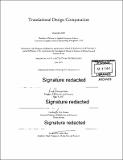| dc.contributor.advisor | Neri Oxman. | en_US |
| dc.contributor.author | Bader, Christoph,Ph. D.Massachusetts Institute of Technology. | en_US |
| dc.contributor.other | Program in Media Arts and Sciences (Massachusetts Institute of Technology) | en_US |
| dc.date.accessioned | 2017-12-20T18:17:06Z | |
| dc.date.available | 2017-12-20T18:17:06Z | |
| dc.date.copyright | 2017 | en_US |
| dc.date.issued | 2017 | en_US |
| dc.identifier.uri | http://hdl.handle.net/1721.1/112913 | en_US |
| dc.description | Thesis: S.M., Massachusetts Institute of Technology, School of Architecture and Planning, Program in Media Arts and Sciences, 2017 | en_US |
| dc.description | Cataloged from PDF version of thesis. | en_US |
| dc.description | Includes bibliographical references (pages 175-183). | en_US |
| dc.description.abstract | This thesis introduces, demonstrates and implements translational design computation: a theoretical approach and technical framework for mediating living and nonliving matter through design computation. I propose that computational design can act as a "language" for the enablement of design at the intersection of the material and the biological domains. I support and validate this proposition by formulating, deploying and evaluating a triad of strategies as follows: (1) Programmable Matter-utilizing computational design in combination with synthetic material systems to enable biologically inspired and informed design; (2) Programmable Templating-utilizing computational design in combination with, and at the intersection of, synthetic and biological systems in order to facilitate their synergetic relationships; and (3) Programmable Growth-utilizing computational design in combination with biological systems to grow material architectures. | en_US |
| dc.description.abstract | Each of these design strategies is demonstrated through specific design challenges. For Programmable Matter; a data-driven material modeling method that allows to reinterpret visual complexities found in nature is presented and subsequently extended to a design framework for the 3D printing of functionally graded structures. For Programmable Templating; a design approach for creating a macrofluidic habitat, exploring phototrophic and heterotrophic bacterial augmentation templated by continuous opacity gradients, is presented. Following, spatio-temporal templating of engineered microorganisms via 3D printed diffusion gradients is investigated. Finally, for Programmable Growth; a framework is proposed with the objective of importing computer-aided design capabilities to biology. Enforcing the design-centric approach, a design collection called Vespers-a reinterpretation of the practice of the ancient death mask-is presented and discussed in the context of the introduced concepts. | en_US |
| dc.description.abstract | Thesis contributions are not limited to innovations in computational design and digital fabrication but also to materials engineering and biology by proposing new ecological perspectives on and for design. | en_US |
| dc.description.statementofresponsibility | by Christoph Bader. | en_US |
| dc.format.extent | 183 pages | en_US |
| dc.language.iso | eng | en_US |
| dc.publisher | Massachusetts Institute of Technology | en_US |
| dc.rights | MIT theses are protected by copyright. They may be viewed, downloaded, or printed from this source but further reproduction or distribution in any format is prohibited without written permission. | en_US |
| dc.rights.uri | http://dspace.mit.edu/handle/1721.1/7582 | en_US |
| dc.subject | Program in Media Arts and Sciences () | en_US |
| dc.title | Translational design computation | en_US |
| dc.type | Thesis | en_US |
| dc.description.degree | S.M. | en_US |
| dc.contributor.department | Program in Media Arts and Sciences (Massachusetts Institute of Technology) | en_US |
| dc.identifier.oclc | 1015245937 | en_US |
| dc.description.collection | S.M. Massachusetts Institute of Technology, School of Architecture and Planning, Program in Media Arts and Sciences | en_US |
| dspace.imported | 2019-06-17T20:30:35Z | en_US |
